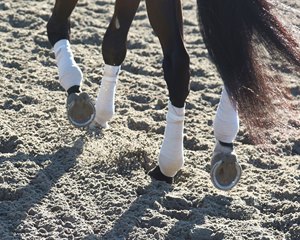Racetrack Surface Panel Embraces Safety Commitment


In an hour-and-a-half discussion that launched the University of Louisville's Equine Industry Program speaker series Sept. 18, a pair of racing surface experts and a track executive applauded the horse racing industry's commitment to horse safety in the months since a spike in horse fatalities at Santa Anita Park this spring.
Mick Peterson, director of the University of Kentucky Ag Equine Program, discussed initiatives undertaken to provide science to improve track maintenance. He was joined by Jamie Richardson, track superintendent at Churchill Downs, and Turfway Park general manager Chip Bach, who provided feedback about how track representatives can best incorporate analytics in an aim to reduce catastrophic injuries in racehorses. Jim Mulvihill, senior director of betting information at Churchill Downs, moderated the panel.
"We can't accept the status quo," said Peterson, a track consultant with over 25 years of experience analyzing racetracks. "We have to continue to improve it."
He pointed to the recently concluded meet at Del Mar as evidence of the positive work that can be done. He mentioned the initiatives of expanded veterinarian exams, diligence from horsemen, thoughtful track and racing office management, and detailed racetrack maintenance as contributing factors that led to no horse suffering a fatal injury during afternoon racing there.
"We need to make every meet like the Del Mar meet—so rare that we don't have to talk about it," Peterson said.
Still, he cautioned that injuries go through periods of spikes and declines and that long-term evaluation provides the most telling information, noting the industry's Equine Injury Database required six years of data to become statistically significant.
"It's not like they have stupid years and smart years," he said of track maintenance staff. "It's not like the equipment has a good year and a bad year."
Santa Anita, which had 30 fatalities over its winter/spring meet, is not alone in experiencing a rash of catastrophic injuries, data shows. There have been periods of increased fatalities at a number of tracks, including Churchill Downs in 2018—though its setbacks did not draw immediate scrutiny. This spring, after horse deaths at Santa Anita became widely tracked, the Louisville Courier-Journal reported Churchill Downs lost 16 horses in 5,656 starts last year, a rate of 2.73 fatal injuries per 1,000 starts, well above the national average.
This year, Churchill's statistics are vastly improved. Richardson said the track had one fatality from racing from approximately 3,500 starters.
The positive stretch in 2019 has done little to calm his anxiety. "I sit there and chew on my fingernails with every race," he said.
While addressing the audience of students, media, and others, he said an attention to detail is vital.
"I don't just proofread one time," he said, referring to a close examination of his maintenance work. "I'm proofreading everything I do two or three times. I am asking all my guys when they come in off the tractors, 'How does it look? What do you think?'"
Although synthetic tracks are statistically safer than dirt surfaces and require less maintenance, Bach said Turfway officials have called upon Peterson's assistance for roughly 10 years. This was meant to improve the synthetic Polytrack surface and to better provide answers to horsemen at the Florence, Ky., track.
"We had a short spate of breakdowns, which is unusual for our track," he said. "Instead of letting it go on, we immediately called these guys up. He sent his person out with ground-penetrating radar, and what we learned was, where the tracks were turning, on and off the racetrack, they were compacting it. It was not perceptible to an eye."
Bach said the obligations for racetrack safety extend to jockeys, pointing to tragedy he witnessed firsthand at Turfway in the winter of 2004 before the track added Polytrack. At the time, Turfway conducted racing over a dirt surface, which struggled handling adverse weather conditions, and jockey Mike Rowland was killed in a breakdown-related spill.
"Up until the time, I looked at racing in a different light," Bach said. "It was fun; it was an exciting sport. But that was the day we all understood what was at stake every time one of these people jumped up on a horse, whether in the morning for workouts or during live racing. It's still something I'll never forget."
Peterson concluded Wednesday's program on an upbeat note, telling the audience he plans to unveil state-of-the-art equipment in the coming weeks. Working with Santa Anita in the lead-up to the Breeders' Cup World Championships Nov. 1-2, he plans to implement new data-gathering prototypes from Racing Surfaces Testing Laboratory, a research organization for which he serves as executive director.
